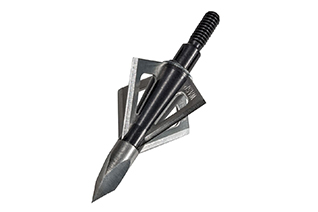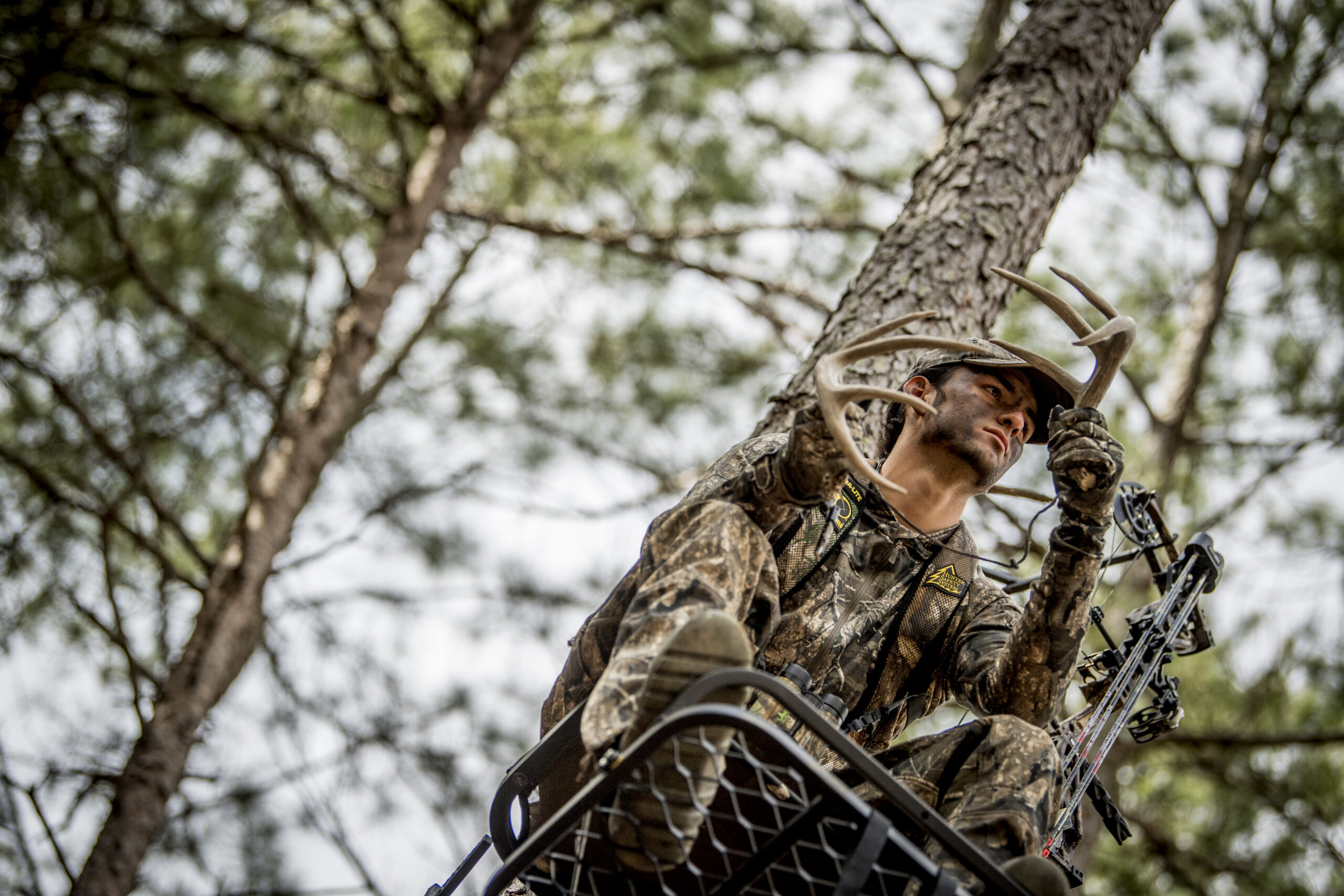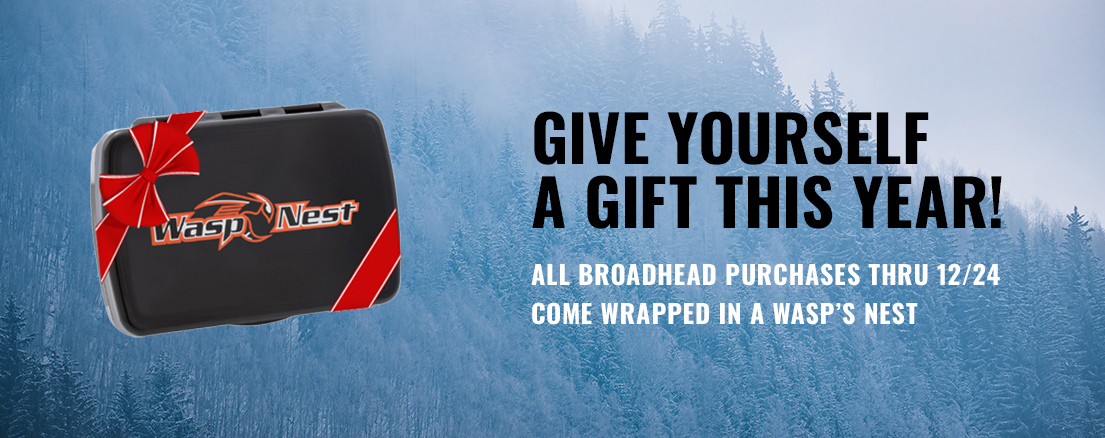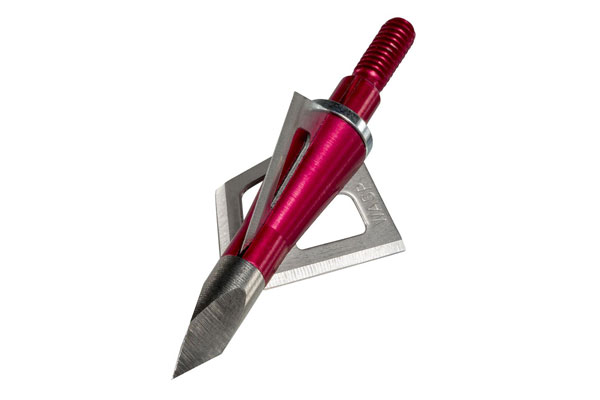You’ve Called Up a Buck. Here’s the Shot to Expect
The opportunity can unfold quickly when you crash antlers together or grunt at a passing buck. Will you be ready?
You spot a buck cruising a distant ridge, and so you grab your rattling antlers and bang them together. The buck stops to pinpoint the location of the fight, then beelines straight toward your stand to address the “intruders” that have moved into his territory. Without calling, the buck would’ve faded away, but now he’s closing in and about to offer you a shot.
Calling can be an extremely effective tactic for hunting whitetails, especially during the pre-rut, rut, and post-rut. Some hunters even have consistent success with it during the early season. Once they shed their velvet, bucks become very territorial and vie to maintain dominance in their core areas. That’s why it’s a great idea to carry a grunt call and rattling antlers every time you hunt whitetails. Inciting an encounter with a grunt call and/or rattling antlers is both effective and exciting, but you must be prepared for high-pressure shot opportunities since you’re triggering a response rather than relying on natural movement patterns. Before you crack the antlers together or hit the grunt call, let’s run through some possibilities.
ON THE GROUND
Calling at eye level is a thrilling way to hunt bucks. In some cases, it allows you to try multiple spots throughout the day. And, you eliminate the declined shot angles you’d have from a treestand. Shooting deer at eye level is a lot like shooting your backyard target in terms of where to aim.
Of course, being on the ground has its challenges, too. Bucks are naturally inclined to pinpoint the exact locations of grunts or rattling. So, you can expect a buck to come in right toward you, looking for other deer. This means that it will be difficult to draw back your bow, plus you might be presented with a head-on or quartering-toward shot angle. If the buck is within top-pin range and you really understand shot placement, these can be doable shots, but take them with caution. If you hold still and the buck doesn’t spot you, it’s possible that he’ll begin circling downwind in an attempt to scent-check the area for the “deer” that he heard. This is when he’ll possibly go from facing to broadside. Wait for his eyes to be obstructed, then draw quickly and take him when he hits an opening.
IN A TREE
A treestand gives you the obvious advantage of being above the buck’s line of sight. This means that as he approaches, you’ll often have plenty of latitude to shift your feet so that you’re positioned perfectly to shoot when the opportunity unfolds. However, you’ll possibly face a very challenging shot opportunity. Again, bucks are great at pinpointing the exact calling location, which means they’ll come in looking.
In open hardwoods, it’s common for bucks to reach the edge of bow range and then stand and stare. If you’re not using a decoy, it’s probable that he’ll either turn to leave or begin circling downwind. Be prepared to draw and mouth-grunt to stop him as he turns to leave, or watch for openings as he circles downwind.
In tighter cover, a buck very well might head straight to the base of your tree. Taking a frontal shot is a poor option since you’re elevated. If you let him keep coming, you’ll likely have a steep downward shot angle on a buck that is quartering slightly toward you. Be careful on this, too, as it’s way too easy to hit only one lung. If the wind is good, your best bet is letting him pass under your tree and then taking the shot as he quarters away behind it.
WITH A DECOY
Hunting with a decoy is a great way to add a visual aid to your calling sequence. The buck comes looking for another buck and sees your decoy, which makes your calling sequence far more authentic. The way you position your decoy largely influences the shot you’ll get. Bucks are likely to face the plastic opponent head-on and from downwind. So, position your decoy upwind from your setup and faced toward you. As the buck approaches the decoy and swings downwind to address it head-on, he’ll usually offer a broadside or slightly quartering-toward angle.
There are also opportunities to hunt deer using more aggressive decoy tactics — we covered this in the previous blog — such as hiding behind a 2-D decoy. In this case, you can usually expect the buck to come directly at you, which means you’ll most likely be presented with a frontal shot angle. Let the buck get extremely close before taking this shot — 20 yards or less — and have a complete understanding of where to hit, since this shot has little margin for error.
ONE LAST TIP
Do you know what can ruin a thrilling encounter resulting from calling in a buck? Taking a poor shot angle and not recovering the animal. Shot opportunities often unfold quickly when a buck responds to calling, and it’s easy to make hasty decisions. Stay calm and be attentive to the buck’s angle as he approaches. If it’s a now-or-never opportunity and you believe your odds of making a double-lung shot are low, hold off. Be patient and wait for a high-percentage angle.
It’s difficult to watch an opportunity fade away, but making a poor shot is far worse. Calling in whitetails is a super-engaging tactic that can be highly effective at specific times of the season, but committing the points addressed in this article to memory will help you to know what you can typically expect for shot opportunities and be ready to properly address them.
SIDEBAR
FOUR LETHAL BLADES

Mechanical, cut-on-contact, and fixed 3-blade broadheads get most of the attention in campfire debates over the best broadheads. But fixed 4-blade broadheads like the Wasp Boss 4-Blade definitely have their place in the woods, and perhaps your arrow quiver. More surface area does create more drag, which can make tuning 4-blade broadheads challenging for some hunters, particularly at longer ranges and high arrow speeds. But other hunters have no problems at all, and love the assurance that an extra 25% more cutting surface provides. The Boss 4-Blade is compact at 1 1/8 inches, and it has a shortened aerodynamic ferrule for more forgiving flight, and Wasp’s legendary SST tip.
— Story by Wasp Archery Staff; Hunter image by Realtree Media
View All Posts

